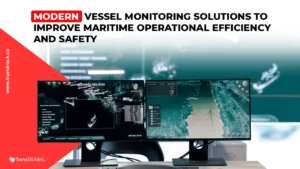The Various Components of Ship Gearbox and Their Working Principles!
Posted on June 5, 2024 by Nur Wachda Mihmidati

A ship gearbox, is an important component in the ship’s propulsion system that serves to change the speed and torque of the main engine so that it matches the needs of the propeller. This gearbox allows the main engine to operate at optimal speed while ensuring the propeller rotates at the speed required to move the ship efficiently. Check out the explanation of the components and working principles of this ship gearbox through the following article TransTRACK!
Ship Gearbox Components
A ship’s gearbox consists of various components that work together to efficiently transmit power from the main engine to the ship’s propeller. The following is a description of the main components:
Gearbox Gasket
Gasket or gaskets prevent oil leakage at gearbox joints, maintaining optimal lubrication. Without a good gasket, lubricating oil can leak, causing wear and tear of internal components. This gasket is usually made of heat- and pressure-resistant materials such as rubber or silicone.
Gearbox Frame
The frame houses and supports all the internal components of the gearbox, providing strength and stability. Made from strong, corrosion-resistant materials such as cast iron or steel, the frame ensures reliable operation. The frame protects the internal components from vibration and heavy operational loads.
Gear Shaft Housing
The gear shaft housing houses and supports the gear shaft, ensuring smooth rotation. It provides the necessary structural support and protects the shaft from contamination and physical damage. Proper housing design is important for optimal gearbox performance.
Clutch Housing
The clutch housing houses the clutch system that allows connection and disconnection of the engine from the gearbox. This provides flexibility in vessel operation, especially during maneuvers or when the engine has to work without moving the propeller. The clutch housing ensures smooth and efficient power transmission.
Input Shaft Cover
The input shaft cover protects the input shaft end from external elements and prevents oil leakage. This cover helps hold the gasket in place, ensuring the input shaft remains protected. Made from corrosion and pressure resistant materials, these covers maintain the operational efficiency of the shaft.
Main Shaft
The main shaft transmits power from the engine to the propeller, withstanding high mechanical loads. Made from extremely strong and durable materials, the main shaft ensures power is transmitted efficiently. It is a key component for reliable vessel operation.
Sun Gear
The sun gear is the central component in the planetary gear system that transfers power to the planetary gear. The sun gear rotates and drives the planet gear that surrounds it, ensuring smooth power transmission. Made with high precision, sun gears play an important role in speed and torque regulation.
Planetary (Planet Gear)
The planetary gear rotates around the sun gear and transfers power to the ring gear or carrier. Planetary systems allow for smooth and efficient speed ratio changes. The planetary gears help distribute the load evenly, reducing wear and increasing the life of the gearbox.
Bearings
Bearings support the shaft and allow rotation with minimal friction. These bearings reduce wear on moving components and support the shaft in the correct position. Bearings must withstand high mechanical loads and harsh operating conditions.
Transmission Gear
Transmission gears transfer power between the input and output shafts, allowing adjustment of the speed ratio according to operational needs. These gears are designed with precision to ensure efficient power transmission and minimal noise. Transmission gears play an important role in the operational efficiency of the gearbox.
Worm Wheel
Worm wheels work in conjunction with worm shafts to transfer power, change direction and rotational speed. This worm and wheel system enables speed changes with high efficiency. Worm wheels are designed to withstand high friction and mechanical loads.
Worm Shaft
The worm shaft interacts with the worm wheel, changing the direction and speed of rotation in the transmission system. Made of extremely strong and wear-resistant materials, worm shafts withstand high mechanical loads. The function of the worm shaft is essential for proper power transmission.
Oil Pump
The oil pump circulates lubricating oil throughout the gearbox, reducing friction and cooling the components. This ensures all moving parts in the gearbox are well lubricated, reducing wear and overheating. The oil pump plays an important role in the maintenance of gearbox health.
Oil Seal
Oil seals prevent oil leakage around rotating shafts, ensuring lubrication remains efficient. These seals are usually made from elastomeric materials that are resistant to oil and high temperatures. The function of the oil seal is very important to maintain the cleanliness and efficiency of the lubrication system.
Oil Hole Cover
The oil hole cover provides access to add or change oil in the gearbox. These covers are designed to be easy to open and close and ensure there is no oil leakage after filling. The oil hole cover usually comes with a gasket to prevent leakage.
Oil Filter
The oil filter filters impurities from the oil to keep the lubrication system clean. It is essential to prevent contamination that can cause wear and damage to the internal components of the gearbox. Effective use of oil filters extends component life and improves operational efficiency.
Out Cover
The outer cover protects the internal components of the gearbox from contamination and physical damage. Made of corrosion- and pressure-resistant materials, these covers ensure the integrity and overall performance of the gearbox. The function of the outer cover is essential for reliable operation and protection of internal components.
Working Principle of Ship Gearbox
The working principle of the ship’s gearbox involves several stages that allow the transmission of power from the main engine to the propeller, regulating the speed and torque suitable for various operational conditions. The following is an explanation of the working principle:
Power Transmission from the Engine
The ship’s main engine generates power which is then transmitted to the gearbox through the input shaft. This power is usually in the form of torque and high rotational speed that needs to be regulated to suit the operational needs of the propeller.
Speed and Torque Regulation
In the gearbox, the power from the engine is received by the transmission gear or planetary gear system. This gear system changes the speed and torque ratio as needed. For example, to start a boat from a standstill, the gearbox lowers the speed but increases the torque, providing greater thrust to the propeller.
Use of Clutch System
The ship’s gearbox is equipped with a clutch system that allows the operator to connect or disconnect the engine from the propeller. This is important for maneuvers, such as when docking or leaving port, as well as when running the engine without moving the propeller.
Rotation and Power Routing
After setting the speed and torque ratio, the power is passed to the main shaft. This main shaft transfers the regulated power to the propellers via the output shaft, converting mechanical power into thrust that propels the vessel through the water.
Lubrication and Cooling
Ship gearboxes are equipped with a lubrication system that ensures all gears and bearings get enough lubricating oil. This lubrication reduces friction, prevents wear, and helps cool the working components inside the gearbox. Lubrication systems are often equipped with oil pumps, oil filters, and oil seals to maintain cleanliness and operational efficiency.
Ratio and Speed Adjustment
The ship gearbox can be adjusted for various gear ratios, allowing the ship to operate at different speeds according to conditions such as open water travel or maneuvering in port. This ratio change is done through an internal mechanism within the gearbox, which can be either a manual or automatic system.
By combining these functions, ship gearboxes enable efficient power transmission from the main engine to the propeller, regulate speed and torque to meet various operational needs, and ensure reliable and long-lasting operation through an effective lubrication system.
After an in-depth look at the importance of ship gearbox in maintaining optimal performance on the high seas, it’s time to move on to modern solutions that can address connectivity challenges in this challenging environment. With TransTRACK’s Hybrid GPS Hybrid GPS and Global SIM Card technology, you no longer have to worry about signal loss at sea. Improve the efficiency and reliability of your vessel operations with TransTRACK. Find the right solution for your needs and make sure every boat trip runs smoothly.
Recent Post
Topic :
Recommended Articles

 Bahasa Indonesia
Bahasa Indonesia








